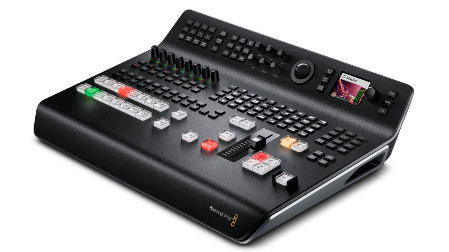Review: Blackmagic Design ATEM Television Studio Pro HD
Production switchers have evolved from their predecessors in that it no longer takes great engineering skill to set up and operate the unit. Blackmagic Design has released the ATEM Television Studio Pro HD live production switcher, which looks and functions much like switchers in the old days, but with eight inputs that mix HDMI, SDI, SD and HD resolution inputs. Consumers and professionals now have a switcher that does it all on location or in the studio.
FEATURES

Straight out of the box, the ATEM Television Studio Pro HD is something to marvel. No longer are black burst, sync or video cables of identical length needed to mix (or time) between video sources. Having installed a video switcher in our university about eight years ago, it took the better part of several days to time all of the inputs and add additional HD component converter boxes so our three high-definition cameras would all function with a switcher that only came with one HD input.
Weighing in at about 9 pounds, the ATEM Television Studio Pro HD is ready to use right from the box (if you supply an AC cable). The rear panel has a DC input if you desire portability on location. The system has four HDMI inputs (switcher keys one through four) and four HD/SDI BNC connections (switcher keys five through eight), which allows you to mix SD and HD inputs. I would like to dwell on this feature for a moment and savor it—you may mix input sources into the switcher without reprogramming, re-timing, or getting additional components. Right out of the box this switcher seems to work in any situation. In my mind, that’s a great leap forward.
An HDMI or a SDI/BNC output (multi-view) displays all camera sources as well as your preview and program on one monitor divided into quadrants. Two XLR inputs ingesting analog audio are to the right of a quarter-inch headphone and quarter-inch microphone jacks. In addition, ports include RS-422, Ethernet and a USB 2.
The switcher also supports NTSC, PAL, 720p 1080i and 1080p with multiple frame rates from 23.98 to 59.94 (I’m still amazed by this). An auxiliary output is assignable and allows you to send an additional program output (or input) to another source other than your multi-view monitor like a projector or large screen display.
The front panel of the ATEM Television Studio Pro HD looks deceivingly complicated, but everything is clearly labeled. Eight preview and program buttons are assigned to each of your video inputs, with cut, mix, wipe and dip transitions. Thirty-six wipe patterns are accessible by simply pressing the corresponding buttons and the Digital Video Effects Processor (DVE) helps with additional built-in transitions.
The upstream keyer features chroma key blue or green, a luminance key, a linear key and 18 pattern keys. The downstream keyer makes adding bugs, logos or titles effortless.
Ten audio channels may be controlled with the built-in audio mixer and 20 graphic files may be stored in the Media Player. The slider allows smooth transitions between inputs and a track ball helps make intricate positioning a breeze. Lastly, a small t3-inch LCD monitor displays the program output directly on the switcher itself.
IN USE
As mentioned earlier, our university recently transitioned into a full 1080p TV studio with a traditional (expensive) switcher and20-inch LCD monitors for each of our three Hitachi 6000 cable and 1080p 48-inch preview and program monitors. Disconnecting the fiber optic cable from each camera and using an SDI cable to go from the camera to the ATEM Television Studio Pro HD, we had three functioning cameras in less than a minute on inputs five, six, and seven—no fuss.
Four additional cameras could be added via the HDMI connections. Since we have only one Blackmagic URSA 4.6K Mini camera, it resided in input one and the three remaining HDMI ports worked with our DSLRs. An HDMI cable from the multi-view output displayed all of the cameras as well as preview and program on one of our Sony Bravia monitors. Again, I didn’t need to worry that the Blackmagic Design, Hitachi 1080p cameras, or DSLRs were of different types—they all played extremely well together.
Our students immediately flocked to this new addition in our control room. The many buttons, red and green colored lights, and multiple transition types were a wow factor for them. Also, seeing the multiview display was an improvement rather than trying to watch six different monitors spread across the room. I haven’t seen this much of a reaction since we transitioned from CRT monitors to flat screen.
One feature I did not have a chance to use is the software control of the switcher for PC and Mac. An included SD card contains this vital information.
I can see this unit being relegated to our sporting events where live remote broadcast is necessary. Taking one of our portable Mac or PCs along will aid our students’ ability with a much higher end result because of live switching rather than editing all of the footage after the event with almost no turnaround time.
With very little set-up time and all cameras talking to each other (with audio), you just need something to actually switch. If we had more Blackmagic Design cameras, there are multiple other features this type of set-up could do.
SUMMARY
The perfect, inexpensive switcher for studio or remote location that allows mixing multiple sources and formats without an issue.
FAST FACTS
Application
The ATEM Television Studio Pro HD functions as an AC or DC switcher, audio mixer and DVE. All you need are the cameras.
Key Features
Multi-format input, AC/DC operation, built in LCD screen, multi-view output, HDMI and SDI inputs, audio mixer, microphone input, DVE, upstream and downstream keyer, rack or desktop mountable and media player.
Price
$2,295.00
Contact
Blackmagic Design
408.954.0500
info-usa@blackmagicdesign.com
www.blackmagicdesign.com
Chuck Gloman is an Associate Professor and Chair of the TV/Film Department at DeSales University. He may be reached chuck.gloman@desales.edu.
Get the TV Tech Newsletter
The professional video industry's #1 source for news, trends and product and tech information. Sign up below.
Chuck Gloman is Associate Professor with the TV/Film Department at DeSales University.

